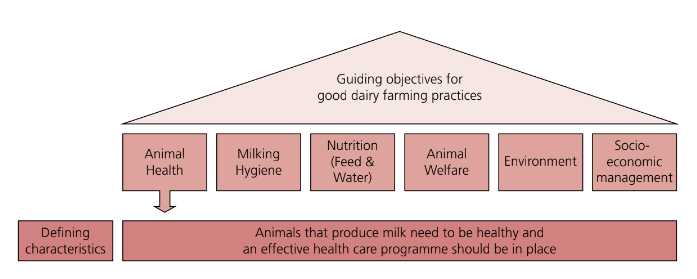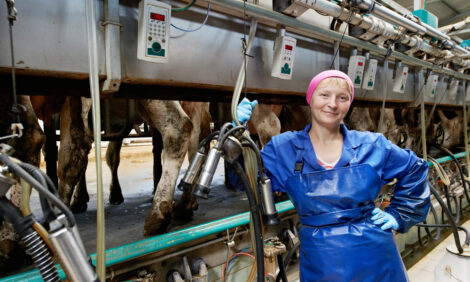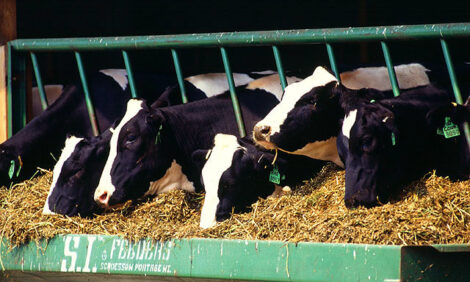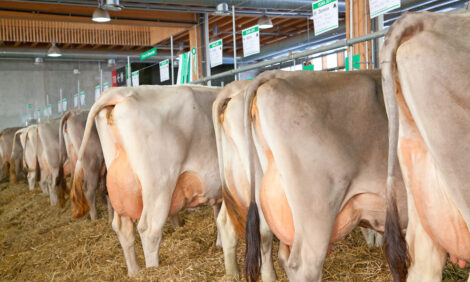



Guide to good dairy farming practice: Animal health
Best practices to improve animal healthPart of Series:
Next Article in Series >
This article is from the Guide to Good Dairy Farming Practices, originally written and published by the Food and Agriculture Organization of the United Nations (FAO) and the International Dairy Federation. The Guide has been written in a practical format for dairy farmers engaged in the production of milk from any dairy species. When adopted, it will support the production and marketing of safe, quality-assured milk and dairy products. Additional sections of the Guide will be published as an article series.
Animal health
This Fact Sheet describes good dairy farming practice to ensure animals that produce milk are healthy and there is an effective health care programme in place. However, not all of the practices are applicable in all circumstances and may be superseded by national, international or market demands.
The suggested good dairy farming practices for animal health are set out under the following headings:
- Establish the herd with resistance to disease.
- Prevent entry of disease onto the farm.
- Have an effective herd health management programme in place.
- Use all chemicals and veterinary medicines as directed.

Establish the herd with resistance to disease
Choose breeds and animals well suited to the local environment and farming system
Different dairy species and breeds have different requirements. Selecting dairy animals that are suited to the local environment will greatly reduce the risks to productivity posed by animal health and welfare problems. Of particular relevance is the animals’ ability to adapt to climatic extremes, feed quality, local parasites (especially ticks) and their acquired resistance to endemic disease.
The demands on the animals also vary with the farming system. Housed animals may have a higher exposure to communicable diseases, whilst extensively maintained animals are more prone to parasitic infections. Animals introduced from different locations may be vulnerable to endemic diseases in the new location due to lack of previous exposure and the development of immunity.
Determine herd size and stocking rate based on management skills, local conditions and the availability of land, infrastructure, feed, and other inputs
Larger herds and higher stocking rates generally require a higher level of organisation, infrastructure and skill to manage. The risks are magnified in these specialised dairy farming systems. Disease burdens can be higher and individual animals requiring intervention can be more difficult to identify and treat. Good planning and management skills are required to manage risks that have serious consequences.
In developing countries overstocking, droughts and fires should be taken into account when determining stocking rates. Drastic seasonal changes (eg Monsoons, deep snow, subzero temperatures, high humidity or heat) may require different farming systems (eg housed or pastures) depending on the time of year. Fodder supplies must be carefully planned for all contingencies as dairy animals require a constant source of good quality feed and water at all times.
Vaccinate all animals as recommended or required by local animal health authorities
Vaccination is a useful tool to limit the impact of disease by increasing the immunity of the animal population to specific pathogens. Animal health authorities can provide dairy farmers with information about the specific vaccines which are recommended for their area. In some dairying regions, dairy farmers are required by law to vaccinate their stock against serious contagious diseases.
Prevent entry of disease onto the farm
Only buy animals of known health status (both herd and individual animals) and control their introduction to the farm using quarantine if indicated
The most effective way to prevent the spread of infectious diseases is to keep a closed herd. This means no new animals enter the herd and previously resident animals do not re-enter after they have left the herd. This is difficult to achieve in practice, so strict control of any animal introductions is essential. Increased risk of disease may also occur when animals share grazing or other facilities. Prior to being introduced to the farm, all dairy herds and animals should be screened for diseases that are significant to their area of origin and new location. All animals should have:
- an identification system to enable trace back to their source (a birth to death identification system); and
- some form of Vendor Declaration or certification that details the health/disease status of animals and any appropriate tests, treatments, vaccinations or other procedures that have been or are being carried out. Potential sellers of dairy livestock must keep appropriate permanent animal health records for their animals. The health status of the vendor herd should also be certified. This is particularly important for diseases with long incubation periods like paratuberculosis etc. Where the animals’ health status is unknown, they should be kept under quarantine or separate to the existing animals for an appropriate length of time. Introduced animals should be inspected on arrival and should be free of external parasites such as ticks. Sick animals should be rejected. It is good practice to consider treating all introduced animals for internal parasites on arrival. Keep records of all animal movements to and from the farm.
Ensure animal transport on and off the farm does not introduce disease
Potential buyers of live animals should always ask and be told if the animals are sick or diseased. Preferably, no sick or infirm animals should be transported alive. A suitably trained operative or a veterinarian should carry out any euthanizing required on-farm. The disposal of diseased and dead animals should be done in a way that minimizes the risk of disease spread and in line with the guidelines in the OIE Terrestrial Animal Code and/or local regulations. For example, transport vehicles should not move dead or diseased animals from one farm to another farm, without taking appropriate actions to minimize the risk of spreading disease.
Monitor risks from adjoining land and neighbours and have secure boundaries
Be aware of local (endemic) diseases and/or exotic diseases which have the potential to affect the health of the herd or flock, especially from neighbouring farms. Contain animals appropriately to ensure there is no risk of disease spread between farms and within farms.
Where possible, limit access of people and wildlife to the farm
People (and vehicles) visiting a number of farms may spread disease between the farms. Keep tanker/milk pick up access and public tracks clear of faecal contamination. Restrict access to an ‘as needs’ basis and put in place appropriate processes to minimize disease spread. Visitors to the farm should wear clean protective clothing and clean, disinfected footwear if entering areas that pose a high risk of transferring disease onto or from the farm. Records of all visitors should be kept as appropriate. Disease can be spread both from and to humans and wildlife. Avoid visitor contact with animals unless necessary.
Have a vermin control programme in place
Ensure that appropriate vermin controls are in place in all areas where vermin could breed, introduce disease and/or affect milk safety and quality. Vermin breeding sites should be eliminated, especially if those sites also harbour disease pathogens, such as manure heaps, livestock disposal sites etc. Vermin control measures may also be required in the milking shed, feed and water storages and animal housing areas. Vermin species vary geographically but can include indigenous animals, rodents, birds and insects.
Only use clean equipment from a known source
Ensure all agricultural and veterinary equipment introduced on to the farm is clean and steps have been taken to prevent the introduction of disease. This may include asking questions about the history of where the equipment comes from and how it has been used. Take extra care with shared or borrowed equipment.
Have an effective herd health management programme in place
Use an identification system that allows all animals to be identified individually from birth to death
All dairy animals should be easily identifiable by all people who come in contact with them. The systems used should be permanent, allowing individual animals to be uniquely identified from birth to death. Examples of identification systems include ear tagging, tattooing, freeze branding and radio frequency identification (RFID) measures such as microchips.
Develop an effective farm herd health management programme focused on prevention that meets farm needs as well as regional and national requirements
Herd health programmes aim to keep all livestock healthy and productive. They should include the farm’s practices for the diagnosis, treatment, prevention and control of relevant animal diseases, including internal and external parasites. It is important to ensure a consistent approach to herd health, so all staff should be aware of and understand the farm’s herd health programme.
The programme should cover all aspects of animal husbandry and handling, milk harvesting as well as other dairy farm management practices relevant to animal health. This may include disease screening, vaccination and/or control measures being required by animal health authorities or supply contracts. Where effective vaccines are available, they may be used to increase resistance to disease. Prophylactic treatments may be required as protective measures when no viable alternative strategy exists. Effective herd health programmes should be developed in consultation with appropriately skilled people such as veterinarians.
Regularly check animals for signs of disease
Observe all animals regularly and use proven methods to aid in detection and accurate diagnosis of infectious disease. Some useful tools may include rectal thermometers, observations of animal behaviour and body condition, and examination of foremilk. Laboratory or other tests may be necessary to screen animals for disease. Herd and/or animal-level disease testing may also be available through statutory disease control programmes or communal milk collection/herd improvement centres.
Detailed breeding and reproductive records should be kept and animals observed at appropriate stages as many diseases are associated with reproduction. Clinical diseases should be investigated to determine the underlying cause(s) so that animals can be treated and further cases prevented. Regular management practices such as hoof care programmes can reduce the incidence of lameness.
Sick animals should be attended to quickly and in an appropriate way
Treat all disease, injury and poor health by proven methods after accurate diagnosis. Treat diseased animals appropriately to minimize the prevalence of infection and the source of pathogens.
Keep sick animals isolated
Where possible and if indicated, keep sick animals isolated on the farm to minimize the spread of contagious disease. Provide separate facilities and/or milk sick animals last. Prompt treatment can limit the spread of infectious agents. Clean and disinfect equipment after it has been in contact with sick animals and ensure people coming into contact with these animals take precautions to avoid infections.
Separate milk from sick animals and animals under treatment
Follow appropriate procedures to separate milk from sick animals and animals under treatment. This milk is not suitable for human consumption and if stored on farm should be clearly labelled as such. Clean milking equipment and utensils thoroughly to avoid cross contamination.
Keep written records of all treatments and identify treated animals appropriately
It is important that staff, veterinarians and others involved with handling dairy animals on the farm know what treatments have been given to which animals. Put in place an appropriate system to readily identify treated animals, and record appropriate details in accordance with local regulations and to manage withholding periods for milk and meat.
Manage animal diseases that can affect public health (zoonoses)
Follow local regulations and OIE recommendations to control zoonoses. Aim to keep diseases of public health significance at a level in animal populations that is not hazardous to people. Avoid direct transmission to people through appropriate animal management and hygienic practices. Ensure the safe disposal of animal waste and carcases. Prevent the contamination of milk with faeces and urine or other animal wastes. Do not use milk from sick animals for human consumption. Manage the risks posed by drinking raw milk from farms.
Use all chemicals and veterinary medicines as directed
Only use chemicals approved for supply and use under relevant legislation
Only use chemicals that have been assessed and registered for use in dairy production by the relevant authority.
Use chemicals according to directions, calculate dosages carefully and observe the appropriate withholding period
Using agricultural and veterinary chemicals for the purpose of which they were approved, and in accordance with label directions, gives a predictable outcome whilst managing the potential risks. Dairy farmers should manage the use of all chemicals to prevent the chemicals adversely affecting animal health and productivity, the health and safety of the user, the environment or the safety and quality of milk and meat products.
Be aware of chemicals that can leave residues in milk. These may include detergents, teat disinfectants, dairy sanitisers, anti-parasitics, antibiotics, herbicides, pesticides and fungicides.
Dairy farmers should:
- use chemicals only for the purpose for which they are approved. For example lactating animals should never be treated with veterinary products that are not recommended for treatment of animals producing milk supplied for processing or otherwise used for human consumption;
- read the label as it will contain all the information about the legal and safe use of the chemical;
- follow the advice given on the label and any chemical data sheet or risk assessment; and
- observe the specified withholding periods.
Only use veterinary medicines as prescribed by veterinarians
Veterinary medicines pose risks to humans, animals and food safety and are subject to special controls on their supply and use. Use only approved veterinary medicines, at the recommended dose according to then label directions, or as prescribed or advised by a veterinarian. Relevant withholding periods must be observed.
All veterinary medicines and chemicals intended for treatment of food-producing animals should have a withholding period stated on the label. If label directions are not strictly followed, the stated withholding period will not be valid. If no withholding time is stated or no labelling instructions exist, the product should not be used. The use of veterinary medicines contrary to the label recommendations is termed ‘off-label use’ and poses additional risks. Off-label use of veterinary medicines must only occur under strict veterinary supervision and in compliance with national/regional regulations.
Store chemicals and veterinary medicines securely and dispose of them responsibly
Store chemicals and veterinary medicines securely to ensure they are not used inappropriately or do not unintentionally contaminate milk and feed. Check and observe product expiry dates. Chemicals and their containers should also be disposed of in a way that will not cause contamination to animals or the farm environment.
Reference: FAO and IDF. 2011. Guide to good dairy farming practice. Animal Production and Health Guidelines. No. 8. Rome.






